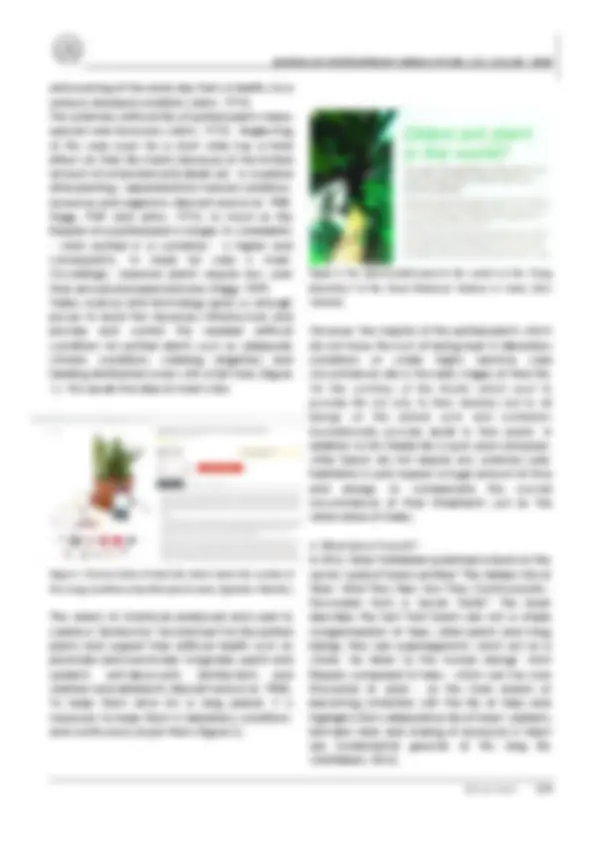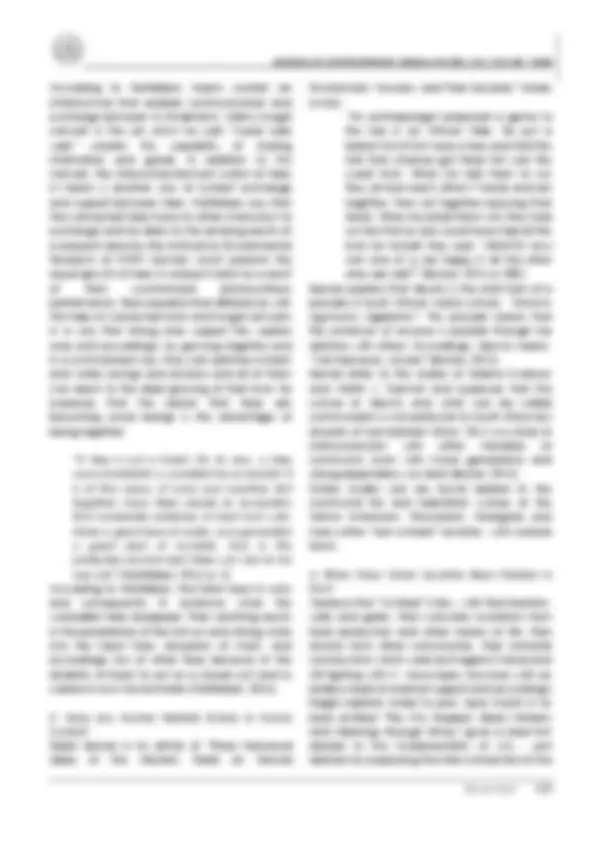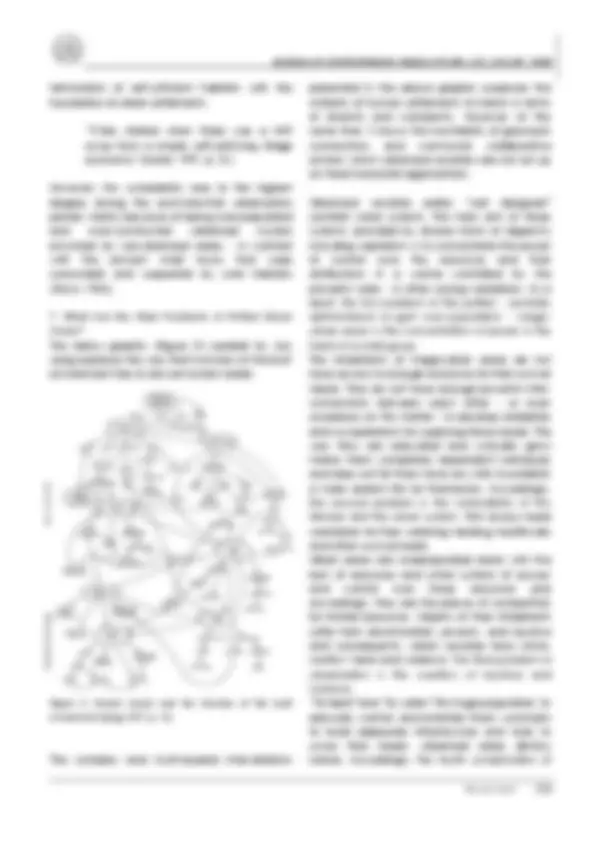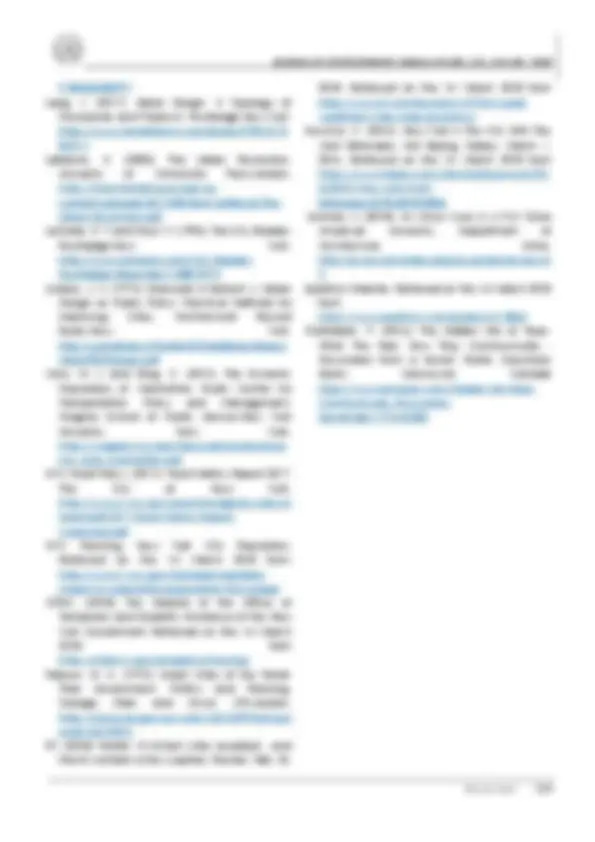






Study with the several resources on Docsity

Earn points by helping other students or get them with a premium plan


Prepare for your exams
Study with the several resources on Docsity

Earn points to download
Earn points by helping other students or get them with a premium plan
Community
Ask the community for help and clear up your study doubts
Discover the best universities in your country according to Docsity users
Free resources
Download our free guides on studying techniques, anxiety management strategies, and thesis advice from Docsity tutors
Urbanization: Planting Forests in Pots
Typology: Essays (university)
1 / 8

This page cannot be seen from the preview
Don't miss anything!





2018 , Volume 2 , Number 2 , pages 122 – 129
Dr. **HOSSEIN SADRI *** Visiting Scholar, the City College of New York, CUNY Associate Professor, Girne American University E mail: hosadri@gmail.com
https://doi.org/10.25034/ijcua.2018. www.ijcua.com Copyright © 201 8 Contemporary Urban Affairs. All rights reserved.
(Nazim Hikmet Ran, 1940)
1. Introduction Last week Reuters released a news related to the newest study on the wealthiest cities of the world and stated that with 3 trillion dollar wealth, New York City is the richest city of the world (RT, 2018). Forbes reports that New York City is the world capital of ultra-rich people with its 79 billionaires (Savchuk, 2016). These and similar news related to New York City creates an image of a prosperous environment in the mind of readers. However, few minutes of surf in the studies and statistics or a short visit to the city is enough to discover the reverse reality of shortage and poverty in the city. Even though there are many systematic and volunteer social support programs, the pains and distresses of New Yorkers are not relieved. Below I will give examples of these social programs on the issues of homelessness and hunger. In spite of the well-developed and functioning aid programs of public and local authorities, which do not regularly exist in other mega-cities and never exist in smaller towns, the insufficiency of these programs is easily readable from the * Corresponding Author: Visiting Scholar, The City College of New York, CUNY Associate Professor, Girne American University, Turkey
This work is licensed under a Creative Commons Attribution
Article history: Received 15 February 2018 Accepted 7 March 2018 Available online 9 March 2018 Keywords: Urbanization; Habitat; Ecology; Resilience; De-Urbanization; New York City.
existing conditions and the growing rates of social problems in the city. Both the state government in New York and the New York City management have several housing aid programs such as the Homeless Housing and Assistance Program (HHAP), the Solutions to End Homelessness Program (STEHP), New York State Supportive Housing Program (NYSSHP), Housing Opportunities for Persons with AIDS Program (HOPWA), Emergency Needs for the Homeless Program (ENHP), and the Operational Support for AIDS Housing Program (OSAH) administered by the Housing and Support Services (HSS) of New York government and Department of Homeless Services New York City (OTDA, 2018). Nevertheless, during the year 2017, 130,000 homeless people including 45, children slept in the municipal shelter system of New York City (Coalition for the Homeless, 2018). According to the reports of the federal government in the United States, the number of homeless people in New York City is the highest one in the United States (Iverac, 2017). In addition to the 250 million meals, which are served in schools, or through the non-profit partners in homeless shelters, care centers and public hospitals, New York City also directly distributes 250 million meals every year. The city management establishes food supporting programs such as Emergency Food Assistance Program (EFAP) which serves 5.5 million Kg of food for 15 million people annually and The Supplemental Nutrition Assistance Program (SNAP) which serves 1.7 million New Yorkers. However, the meal gap in New York City is very high; and 225 million meals are missing from the homes of the families struggling with food insecurity every year. There are almost 1.3 million food-insecure New Yorkers. (NYC Food Policy, 2017). New York City has the highest number of food insecure individuals in the United States (Feeding America, 2017)
2. Where the Problem Comes From? New York City contains almost the same variety of the problems that all other urban areas around the world are facing, with a much more gravity and seriousness. In this sense, New York is a prototypical urban area in which a huge number of people with the variety of problems and opportunities are aggregated (Lindsay, 1974). Supplying the needs of these people is highly dependent on the systematic tools, technological means, resources and energies. Robson declares that without these supports, the survival of these vast aggregations of people in their concentrated urban areas is impossible. He underlines the dependency of urban inhabitants on the machines and mechanisms of transfer, filtration, and administration of drinking water, or the services and systems of waste collection and sewerage (Robson, 1972). This urban society is the result of industrialization and domination of capitalism and as Lefebvre explains is highly interrelated with the establishment of urban infrastructures (Lefebvre, 2003). These supporting systems and infrastructure are developed to fulfill the missing functions of the human habitat that in any natural habitat originally exists. This artificiality and vulnerability of urban habitat and its dependency on external energies support and care from the outer resources, reminds me the condition of a potted plant. 3. How Potted Plants Survive? Plants originally grow on earth under the conditions deriving from their co-operations and inter-relations with other living beings such as plants, fungi, microbes, insects and animals, in addition to other climatic and physical conditions. These co-operations create some niches such as microclimates supportive to the growth of a specific plant and build a resilient environment for its life. The highest resiliency and sustainability, the best living conditions and overall performances of plants can be found in forests where the most diverse and strong inter- connections exist. Conversely, potted plants and their fragile life conditions originate from their complete isolation from the resources of life such as water and food, and their destitution from any solidarity and collaboration. Johns expresses this instability with the mutative health conditions of potted plants changing even between morning
According to Wohlleben, forests contain an infrastructure that enables communication and exchange between its inhabitants. Mainly fungal network in the soil which he calls “wood wide web” creates this capability of sharing information and goods. In addition to this network, the interconnected root system of trees in forests is another way of nutrient exchange and support between trees. Wohlleben says that the connected trees have no other choice but to exchange and he refers to the amazing results of a research done by the Institute for Environmental Research at RWTH Aachen which presents the equal growth of trees in a beech forest as a result of their synchronized photosynthesis performance. Trees equalize their differences with the help of connected roots and fungal networks in a way that strong ones support the weaker ones and accordingly, by growing together and in a synchronized way, they can optimize nutrient and water savings and divisions and all of them can reach to the ideal growing of their kind. He expresses that the reason that trees are becoming social beings is the advantage of being together: “ A tree is not a forest. On its own, a tree cannot establish a consistent local climate. It is at the mercy of wind and weather. But together, many trees create an ecosystem that moderates extremes of heat and cold, stores a great deal of water, and generated a great deal of humidity. And in this protected environment trees can live to be very old ” (Wohlleben, 2016, p: 4). According to Wohlleben, the forest loses its unity and consequently its existence when the vulnerable trees disappear. Their vanishing results in the penetration of the hot sun and strong winds into the forest floor, disruption of moist, and accordingly loss of other trees because of the disability of forest to act as a closed unit and to create its own microclimate (Wohlleben, 2016).
5. Have any Human Habitats Similar to Forests Existed? Ralph Becker in his article of “Three Delusional Ideas of the Western World on Natural Environment, Humans, and Their Societies” shares a story: “An anthropologist proposed a game to the kids in an African tribe. He put a basket full of fruit near a tree and told the kids that whoever got there first won the sweet fruits. When he told them to run they all took each other’s’ hands and ran together, then sat together enjoying their treats. When he asked them why they had run like that as one could have had all the fruits for himself they said: “UBUNTU! How can one of us be happy if all the other ones are sad?” (Becker, 2015, p: 382). Becker explains that Ubuntu is the short form of a proverb in South African Xosha culture: “Umuntu ngumuntu ngabantu”. This proverb means that the existence of anyone is possible through her relations with others. Accordingly, Ubuntu means, “I am because, we are” (Becker, 2015). Becker refers to the studies of Dalene Swanson and Martin J. Gannon and expresses that the culture of Ubuntu and what can be called communalism is not particular to South Africa but all parts of Sub-Saharan Africa. This is a culture of interconnection with other members of community even with future generations and strong dependency on land (Becker, 2015). Similar studies can be found related to the communal life and habitation culture of the Native Americans, Polynesians, Aborigines and many other “non-civilized” societies - with colonial terms. 6. When Have Urban Societies Been Planted in Pots? I believe that “civilized” cities - with their bastions, walls and gates, their concrete insulations from food production and other means of life, their division from other communities, their immortal constructions which were built against nature and still fighting with it - have been structures with an endless need of external support and accordingly fragile habitats similar to pots. Spiro Kostof in his book entitled “The City Shaped: Urban Patterns and Meanings through History” gives a clear hint related to the fundamentality of city - pot relations by expressing the inter-connection of the
termination of self-sufficient habitats with the foundation of urban settlements: “Cities started when there was a shift away from a simple, self-satisfying village economy” (kostof, 1991, p: 31) However, this vulnerability rose to the highest degree during the post-industrial urbanization period, mainly because of being over-populated and over-constructed urbanized clusters encircled by sub-urbanized areas - in contrast with the ancient small towns that were surrounded and supported by rural habitats (Davis, 1965).
7. What Are the Main Problems of Potted Urban Areas? The below graphic (Figure 3) created by Jon Lang expresses the way that functions of the built environment tries to answer human needs. Figure 3. Human needs and the function of the built environment (Lang, 2017, p: 15) The complex and multi-layered inter-relations presented in the above graphic expresses the similarity of human settlements to forests in terms of diversity and complexity. However, at the same time, it shows the inevitability of grassroots connections and communal collaborative actions which urbanized societies are not set up on these horizontal organizations. Urbanized societies prefer “well designed” centrally ruled systems. The main aim of these systems, provided by diverse forms of oligarchy including capitalism, is to concentrate the power of control over the resources and their distributions in a centre controlled by the powerful rulers - in other saying caretakers. As a result, the first problem of the potted - centrally administered on-grid over-populated - mega- urban areas is the concentration of power in the hand of a small group. The inhabitants of mega-urban areas do not have access to enough resources for their survival needs. They do not have enough powerful inter- connections between each other - or even awareness on this matter - to develop solidarities and co-operations for supplying these needs. The way they are educated and culturally grow makes them completely dependent individuals and does not let them have any skills to establish a more resilient life for themselves. Accordingly, the second problem is the vulnerability of this lifestyle and the urban system. Pots always need caretakers for their watering, feeding, healthcare and other survival needs. Urban areas are overpopulated areas with the lack of resources and unfair systems of access and control over these resources and accordingly, they are the places of competition for limited resources. Majority of their inhabitants suffer from discrimination, poverty, and injustice and consequently, urban societies face crime, conflict, terror and violence. The third problem of urbanization is the creation of injustice and violence. “To feed” and “to water” this huge population, to educate, control, and entertain them, summarily to build adequate infrastructure and tools to cover their needs, urbanized areas destroy nature. Accordingly, the fourth complication of
physical environment must be regenerated in a way that settlements exist in harmony with nature. Additionally, anthropocentric and individualist mind-set of urban societies must be culturally rehabilitated. As the second way, with correct strategies, reforestation of deserts can be realized. In other words, communities outside of the existing system can investigate on the re- building of human nature and human-human relations and spread their alternative achievements to the global community. Following any of these ways, the new human habitation model must be as diverse, multi- layered and complex as cities, but distinctively with strong relations to its land, permanent and multigenerational strategies, self-sufficient and off-grid settlements in harmony with nature, horizontal organizations, and people with strong loyalty to communal life and solidarity. The hazardous conditions of global human society and planet today, lead us to try these solutions. Either we will win and natural life will be regenerated or nature will win and will be regenerated - but without us. Acknowledgments This article is developed from the author’s lecture entitled “Plants in Pots: Architecture and Power” in the 25th of January of 2017 at Abdullah Gul University in Kayseri, TURKEY. Most of the information during this research accessed from the SSA, CCNY, CUNY library and New York Public Library. References Barnett, J. (1974). Urban Design as Public Policy: Practical Methods for Improving Cities, Architectural Record Books:New York. https://books.google.com.tr/books/about/Urba n_Design_as_Public_Policy_Practical.html?id=a kFtAEACAAJ&redir_esc=y Becker, R. M. (2015). Three Delusional Ideas of the Western World on Natural Environment, Humans, and Their Societies, Estudos de Sociologia, Recife, 2015, Vol. 2 n. 21. https://www.academia.edu/35836859/Three_D elusional_Ideas_of_the_Western_World_on_Natu ral_Environment_Humans_and_Their_Societies Beckett, K. A., Carr, D. and Stevens, D. (1983) .The Containered Garden, The Viking Press: New York. https://www.amazon.com/Contained- Garden-Revised-Kenneth- Beckett/dp/ Coalition for the Homeless. (2018). New York City Homelessness: The Basic Facts, Retrieved on the 1st March 2018 from: http://www.coalitionforthehomeless.org/wp- content/uploads/2018/02/NYCHomelessnessFa ctSheet_12-2017_citations.pdf Davis, K. (1965). The Urbanization of the Human Population in LeGates, R. T. and Stout, F. (1996) The City Reader, Routledge: New York. http://hiebertglobalcenter.org/blog/wp- content/uploads/2013/04/Reading- 7 - Davis-The- Urbanization-of-the-Human-Population.pdf Feeding America. (2017). Map the Meal Gap 2017, The Howard G. Buffett Foundation, Retrieved on the 1st March 2018 from http://www.feedingamerica.org/research/map
Lang, J. (2017). Urban Design: A Typology of Procedures and Products, Routledge:New York. https://www.taylorfrancis.com/books/ 82914 Lefebvre, H. (2003). The Urban Revolution, University of Minnesota Press:London. https://thecharnelhouse.org/wp- content/uploads/2017/08/Henri-Lefebvre-The- Urban-Revolution.pdf LeGates, R. T. and Stout, F. (1996). The City Reader, Routledge:New York. https://www.amazon.com/City-Reader- Routledge-Urban/dp/ Lindsay, J. V. (1974). Foreword, in Barnett, J, Urban Design as Public Policy: Practical Methods for Improving Cities, Architectural Record Books:New York. http://usd.tehran.ir/Portals/0/DataBase/Library/ Urban%20Design.pdf Moss, M. L. and Qing, C. (2012). The Dynamic Population of Manhattan, Rudin Center for Transportation Policy and Management, Wagner School of Public Service:New York University, New York. https://wagner.nyu.edu/files/rudincenter/dyna mic_pop_manhattan.pdf NYC Food Policy. (2017). Food Metrics Report 2017, The City of New York. https://www1.nyc.gov/assets/foodpolicy/downl oads/pdf/2017-Food-Metrics-Report- Corrected.pdf NYC Planning, New York Cİty Population, Retrieved on the 1st March 2018 from: https://www1.nyc.gov/site/planning/data- maps/nyc-population/population-facts.page OTDA. (2018). the Website of the Office of Temporary and Disability Assistance of the New York Government Retrieved on the 1st March 2018 from https://otda.ny.gov/programs/housing/ Robson, W. A. (1972). Great Cities of the World: Their Government, Politics and Planning, George Allen and Unwin LTD:London. https://trove.nla.gov.au/work/10515599?q&versi onId= RT. (2018) World's 15 richest cities revealed - and the list contains a few surprises, Reuters, Feb. 25, 2018, Retrieved on the 1st March 2018 from https://www.rt.com/business/419764-world- wealthiest-cities-map-economy/ Savchuk, K. (2016). New York Is The City With The Most Billionaires, Not Beijing, Forbes, March 1, 2016, Retrieved on the 1st March 2018 from https://www.forbes.com/sites/katiasavchuk/ 6/03/01/new-york-most- billionaires/#49c8f593489d Sonmez, S. (2018). An Urban Area in a Pot. Girne American University, Department of Architecture, Girne. http://ijcua.com/index.php/ijcua/article/view/ 2 Sparkfun Website, Retrieved on the 1st March 2018 from https://www.sparkfun.com/products/ Wohlleben, P. (2016). The Hidden Life of Trees: What The Feel, How They Communicate - Discoveries from a Secret World, Greystone Books: Vancouver, Canada https://www.amazon.com/Hidden-Life-Trees- Communicate_Discoveries- Secret/dp/